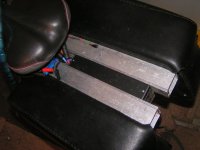The QS Motor 205 50H V3 arrived! It's a beast. About 16 kg in the rim?
https://imgur.com/a/umuww
Also some updates to the battery box design. It is close to being sent out for fabrication, I found a good sheet metal place. It will be 2mm aluminium, anodised black, with a form-fitting lid screwed on. All the holes/connectors have been located in the diagonal rear section.
Current hole configuration:
3x 13mm holes for waterproof cable glands for phase wires
1x 22.5mm hole for a waterproof charge connector
(Shenzen Linko 4-pin, http://cnlinko.en.alibaba.com/product/60126619045-800792386/4Pin_Quick_Plug_Flat_Electrical_Plug_and_Socket_Connector.html )
2x 20mm hole to allow display and hall sensor plugs to pass through
2x 12mm holes for on/off key switch and goretex vent
Now that I have taken a look at the motor and stock wiring, I am considering ditching the separate phase and hall connections, and running the entire sheathed motor cable section into the enclosure. The supplied cable is 1.8m long! I could very well just lose the supplied flat lugs and hall plugs, along with a great deal of cable length, and terminate directly into the Adaptto-supplied XT150 and hall connectors, and run it into a single large cable gland (I have a nice selection of sizes with beautiful camera-shutter seals).
The welder lives! I made up some spot welding probes from 8mm copper rod stock, and threaded them to accept a 1.25 metric thread. Easy to change if I need to take them off to sharpen. I was able to weld 0.3mm nickel (through-strip only so far however) using a 20V capacitor voltage. They will go to 50V if needed (6x the stored energy). The tests so far have just used a single 10 ms pulse from a digital signal generator, I will need to sort out the proper double pulse timing, program my arduino, sort out a footswitch of some kind, and possibly braid the welding cables together to get a lower inductance and hence lower the energy requirement for absorption by the snubber caps and FETs.




